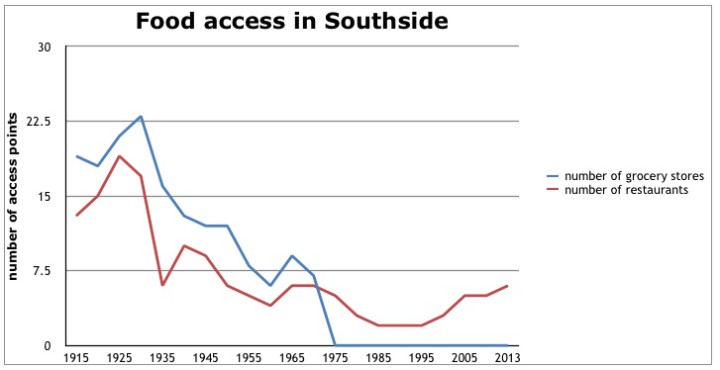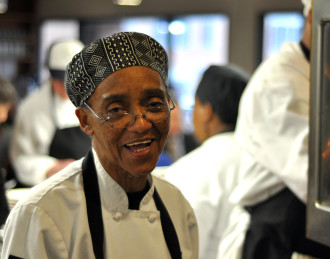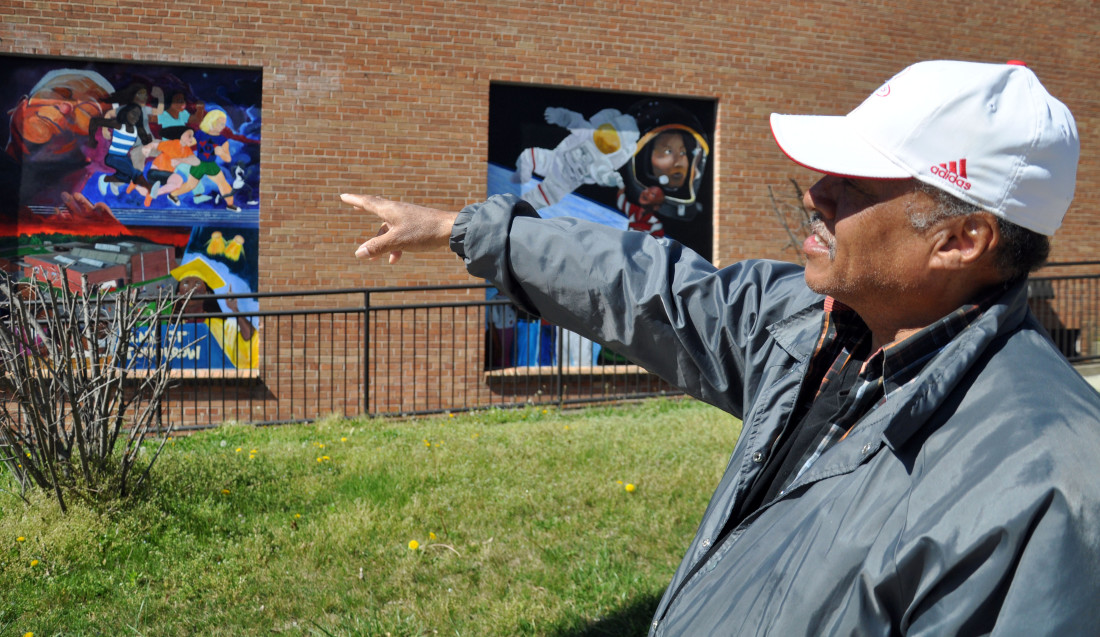Since May 2015, UNC Asheville graduate Erin Daniell, a resident of Asheville’s Southside neighborhood, has conducted an ongoing research project on the roots and realities of food insecurity in this historically black community. In a two-part series of stories for Xpress, Daniell presents her findings.
Of the many narratives about Asheville, its reputation as a dining destination undoubtedly draws flocks of tourists and new residents alike every year. “’Foodtopia’ is what we call our food scene in Asheville, N.C., home to a community of culinary collaborators crafting an experience to nurture your soul,” boasts Explore Asheville, the city’s tourism website. Yet hidden within this so-called Foodtopia, a large portion of Asheville’s population faces food insecurity.
The Asheville area is home to six food deserts, according to the U.S. Department of Agriculture. People living within these areas lack grocery stores within a mile of their homes, which is considered walking distance when carrying grocery bags in the absence of reliable transportation. And in this city of nearly 88,000 people and 11 Ingles grocery stores, all nine of its public housing apartment complexes are located a mile or more away from an Ingles, an affordable grocery shopping option.
Food insecurity is a problem for all residents who are struggling economically in the Asheville area, but the black community is disproportionately affected. According to the study State of Black Asheville, blacks, who represent 13 percent of the population and 71.8 percent of public housing residents, must travel over a mile for affordable groceries. The genesis of this disproportionate food insecurity in Asheville’s black community took hold decades ago when racially charged policies — most prominently, the city’s urban renewal projects of the 1970s — were carried out.
One food desert that’s right in the heart of Foodtopia is the historically black Southside neighborhood, just south of downtown Asheville. With four of the city’s nine public housing complexes located there and a population that is, according to the 2010 U.S. census, 55 percent black, Southside is an effective place to evaluate the roots of Asheville’s racial food insecurity.
Segregated but food-secure
During the Jim Crow years, Southside was a segregated black neighborhood whose residents made up half of the city’s total black population, says a study carried out by the Redevelopment Commission of the City of Asheville in 1966. Hanan Shabazz, a well-known local chef and resident of Southside since the mid-1960s, recalls corner stores, fruit trees and gardens scattered throughout the neighborhood in the era of segregation. It was a time of food security.

“We had access, but, of course, [the neighborhood corner stores] were twice as expensive as grocery stores [outside of Southside],” says Shabazz. But corner stores played a critical role in the community. They helped people cover their basic needs, including produce. They also maintained a credit system, allowing people to take home groceries when money was short and pay for them later.
Local community organizer and longtime Southside resident Shuvonda Harper remembers hearing tales of the fruit tree orchard her great-grandmother kept in her backyard on Phifer Street. Along with local stores, residents relied on the abundance they could cultivate on their land. Harper says her great-grandmother’s property “had fruit trees — grapevines, pear trees, apple trees, black walnut trees, cherry trees. So my mom grew up with … this stuff accessible right in their backyard.” After the harvest, her great-grandmother canned anything that hadn’t already been consumed so they had food to get through winter.
Urban renewal
The harbinger of changes to this way of life began after World War II, when a relatively new phenomenon called urban renewal took hold in the United States. Cities across the country tasked themselves with pinpointing areas of what was termed “blight,” then created revitalization plans to be approved and funded by the federal government. Wealthy white men were largely responsible for identifying blighted areas and coming up with new development plans. Most often they found blight in traditionally black neighborhoods of urban areas. Cities then used eminent domain to acquire land, tear down homes and rebuild the area, displacing longtime residents from their homes and destroying connections to their sense of community.
Urban renewal took place in Asheville decades after the country’s first projects, but with no less disastrous effects. “Inside East Riverside,” a 1966 community study conducted by the Redevelopment Commission of the City of Asheville to prepare for urban renewal, reported, “Although a majority of the structures in the area have been classed as blighted and community facilities are obviously deficient, two out of three people who live here like the neighborhood ‘fine,’ and only one in 10 dislikes it.” The study also reported that “in leaving East Riverside [Southside], respondents feel they would miss people most.” One of the community’s strongest recommendations for the ensuing development project was to build a supermarket in the neighborhood.

As Asheville began to carry out urban renewal efforts in the early 1970s, Southside became the site of the East Riverside Project, the largest urban renewal project in the city and the entire Southeast, noted Southside resident Priscilla Ndiaye in “Twilight of a Neighborhood: Asheville’s East End, 1970,” a public humanities project partially funded by the N.C. Humanities Council. Acting through eminent domain, the city of Asheville bought Southside homes to be either renovated or torn down and rebuilt. New residents moved in while longtime residents relocated to public housing under the city’s displacement plan, despite the 1966 study finding that a majority of residents did not endorse this option.
Urban renewal efforts brought four public housing developments to Southside: Lee Walker Heights, Livingston and Erskine-Walton, Aston Park Tower and Bartlett Arms. Despite a call to address food-access issues, no supermarkets were built. Instead, between 1970 and the middle of the urban renewal projects in 1975, the number of grocery stores in Southside dropped from seven to zero. And those businesses never returned to the area (see graph).
Root shock
Longtime residents of Southside harbor strong feelings to this day about the effect urban renewal had on their community. “I think that they bullsh*tted people around in that [urban renewal] time,” says Shabazz. “They took people’s property and displaced them, and you know these people had houses and they were run-down houses, the majority of them, but nevertheless they were homes. I felt like they [city officials guiding the East Riverside urban renewal project] actually put people [Southside residents] in a position, thinking that they were bettering themselves, and they wind up losing all of their independence and everything, and they start placing them in concentration camps.”
Shabazz refers to public housing apartments as concentration camps because most of the complexes in Asheville have only one entrance/exit that is often watched by a security guard. To Shabazz, the displacement of community was the worst consequence of the East Riverside urban renewal project.
Harper’s family was greatly affected by the urban renewal project. Like so many residents in Southside, her great-grandmother faced a lot of pressure to sell her house during that era. Finally, when her husband died, she relented. While she did not sell directly to the city, the results were the same — a loss of personal assets and community connections that made escaping life in public housing exceedingly difficult. Three generations later, Harper and her children live in the Erskine-Walton Apartments.

The East Riverside Project tore down hundreds of homes and businesses and displaced thousands of people. The plan called for the displacement of at least half of Southside residents. Dr. Mindy Fullilove, a professor of public health and clinical psychiatry at Columbia University, created the term “root shock” to describe this experience. In her 2004 book, Root Shock: How Tearing Up City Neighborhoods Hurts America, and What We Can Do About It, Fullilove writes, “Root shock is the traumatic stress reaction to the destruction of all or part of one’s emotional ecosystem.” Dr. Sarah Judson, a professor of history at UNC Asheville, further notes, “It [root shock] results in a rupturing of individual and communal identity.”
For Southside residents, root shock resulted in the loss of critical social and cultural assets and knowledge — foundational qualities that lead to social mobility and the establishment of new local businesses, including grocery stores. Additionally, urban renewal created physical barriers to the establishment of new businesses in Southside, most notably, the dramatic alteration of Southside Avenue. This major business corridor was the only thoroughfare that diagonally traversed the entire Southside neighborhood before urban renewal, but the East Riverside Project chopped Southside Avenue down to a third of its original length.
“The city basically rolled up the street,” says Roy Harris, a retired engineer, local historian and resident of Southside. Harris believes the road likely became the neighborhood’s namesake because of its previous importance to the community. From 1915-70, Southside Avenue was consistently home to about half of the grocery stores in the neighborhood, according to old volumes of Hill’s Asheville City Directory. Harris says the project effectively cut off access to numerous businesses.
The Redevelopment Commission of the City of Asheville carried out an extensive study aimed at finding what the residents of Southside needed and wanted from the East Riverside urban renewal project. However, a system allowing Southsiders to effectively hold the commission accountable to the study’s findings was lacking. This resulted in concentrating the city’s black community in public housing complexes and eliminating the food security residents had previously experienced for decades in Southside.
In August, the second installment of this series will examine Southside’s current experience of food insecurity and gentrification.




Once again Mountain XPress has done a great community service by publishing this article.
Local politicians and others should be taking a look at Republican budget cut proposals and be expecting big changes here foodstamp/EBT cuts for example. This will get much worse.
LOL fools don’t realize you’re subsidizing the low wages of businesses. Why on Earth should anyone working at say Biltmore, Tupelo Honey, or any other million dollar CORPORATION also need welfare? Maybe people should look at the local crony Democrats instead. They seem to be big proponents of not only low wages, but also of crony capitalism as well.
Let me add that anyone who is working in Asheville for pittance while these thieves come here and make bank should place the blame squarely on progressive Democrats. They are the reason that people aren’t able to make it.
The filing deadline is noon tomorrow.
SO, HOW do we slowly grow ourselves out of all these public housing projects? WHEN will the Housing Authority seek to MAINSTREAM their residents thereby reducing need ?
WHEN will Gene Bell RESIGN and city council steps up to choose a REAL LEADER for public housing ? Bell needs to go… Zero leadership skills for his job.
The filing deadline is noon tomorrow.
Ms. Shabazz is RIGHT….public housing communities are like concentration camps … let’s get them OUT of Asheville once and FOR ALL !
Congratulations for completely missing Ms Shabazz’s point.
How so ? I think she made quite the clear point, that SHOULD have been expounded upon …
It’s a choice, not a requirement, to create public housing that resembles a prison camp. There’s no inherent reason why public housing can’t be integrated within existing communities. (Other than the reason that other people want it out of sight and out of mind.) There is value in public housing; Asheville has historically handled it badly; it’s important to learn from past mistakes. I’ll look forward to Erin’s next piece.
We might actually be in total agreement here. It’s hard to tell sometimes.
LOL the only thing public housing does is keep people down. Generational housing for decades ais proof of that.
Did you file?